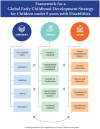Early childhood development strategy for the world's children with disabilities
- PMID: 38962774
- PMCID: PMC11220280
- DOI: 10.3389/fpubh.2024.1390107
Early childhood development strategy for the world's children with disabilities
Abstract
Early childhood is foundational for optimal and inclusive lifelong learning, health and well-being. Young children with disabilities face substantial risks of sub-optimal early childhood development (ECD), requiring targeted support to ensure equitable access to lifelong learning opportunities, especially in low- and middle-income countries. Although the Sustainable Development Goals, 2015-2030 (SDGs) emphasise inclusive education for children under 5 years with disabilities, there is no global strategy for achieving this goal since the launch of the SDGs. This paper explores a global ECD framework for children with disabilities based on a review of national ECD programmes from different world regions and relevant global ECD reports published since 2015. Available evidence suggests that any ECD strategy for young children with disabilities should consists of a twin-track approach, strong legislative support, guidelines for early intervention, family involvement, designated coordinating agencies, performance indicators, workforce recruitment and training, as well as explicit funding mechanisms and monitoring systems. This approach reinforces parental rights and liberty to choose appropriate support pathway for their children. We conclude that without a global disability-focussed ECD strategy that incorporates these key features under a dedicated global leadership, the SDGs vision and commitment for the world's children with disabilities are unlikely to be realised.
Keywords: Sustainable Development Goals; developmental disabilities; early childhood development; global strategy; inclusive education; nurturing care framework; school readiness; twin track approach.
Copyright © 2024 Olusanya, Wright, Smythe, Khetani, Moreno-Angarita, Gulati, Brinkman, Almasri, Figueiredo, Giudici, Olorunmoteni, Lynch, Berman, Williams, Olusanya, Wertlieb, Davis, Hadders-Algra and Gladstone.
Conflict of interest statement
The authors declare that the research was conducted in the absence of any commercial or financial relationships that could be construed as a potential conflict of interest. The author(s) declared that BOO was an editorial board member of Frontiers, at the time of submission. This had no impact on the peer review process and the final decisio.
Figures
Similar articles
-
Prioritising rehabilitation in early childhood for inclusive education: a call to action.Disabil Rehabil. 2023 Sep;45(19):3155-3159. doi: 10.1080/09638288.2022.2118870. Epub 2022 Sep 6. Disabil Rehabil. 2023. PMID: 36066022
-
Promoting school readiness in children with developmental disabilities in LMICs.Front Public Health. 2023 Feb 22;11:993642. doi: 10.3389/fpubh.2023.993642. eCollection 2023. Front Public Health. 2023. PMID: 36908404 Free PMC article. Review.
-
Inclusive early childhood development (IECD): A twin-tracking approach to advancing behavioral health and social justice.Am J Orthopsychiatry. 2019;89(4):442-448. doi: 10.1037/ort0000351. Epub 2018 Jul 26. Am J Orthopsychiatry. 2019. PMID: 30047743
-
Effects of disability on early childhood development in 3 to 4-year-old children in three South Asian countries: evidence from multiple indicators cluster surveys.BMC Pediatr. 2025 Mar 13;25(1):189. doi: 10.1186/s12887-025-05525-8. BMC Pediatr. 2025. PMID: 40075317 Free PMC article.
-
Accelerating progress on early childhood development for children under 5 years with disabilities by 2030.Lancet Glob Health. 2022 Mar;10(3):e438-e444. doi: 10.1016/S2214-109X(21)00488-5. Epub 2022 Jan 14. Lancet Glob Health. 2022. PMID: 35038406 Free PMC article. Review.
Cited by
-
Advancing early childhood development for children with disabilities and the Global Disability Summit 2025.BMJ Paediatr Open. 2025 Jun 24;9(1):e003595. doi: 10.1136/bmjpo-2025-003595. BMJ Paediatr Open. 2025. PMID: 40555557 Free PMC article. No abstract available.
-
Parents' Perceptions Regarding Needs and Readiness for Tele-Practice Implementation Within a Public Health System for the Identification and Rehabilitation of Children with Hearing and Speech-Language Disorders in South India.Int J Environ Res Public Health. 2025 Jun 16;22(6):943. doi: 10.3390/ijerph22060943. Int J Environ Res Public Health. 2025. PMID: 40566369 Free PMC article.
-
Interdisciplinary fetal-neonatal neurology training improves brain health across the lifespan.Front Neurol. 2024 Jul 4;15:1411987. doi: 10.3389/fneur.2024.1411987. eCollection 2024. Front Neurol. 2024. PMID: 39026582 Free PMC article. Review.
-
A Comparison of Developmental Profiles of Preschool Children with Down Syndrome, Global Developmental Delay, and Developmental Language Disorder.Healthcare (Basel). 2025 Jul 13;13(14):1684. doi: 10.3390/healthcare13141684. Healthcare (Basel). 2025. PMID: 40724709 Free PMC article.
-
Neurodevelopmental disorders at Chris Hani Baragwanath Academic Hospital: a 4-year retrospective database review.BMJ Paediatr Open. 2025 Apr 20;9(1):e003373. doi: 10.1136/bmjpo-2025-003373. BMJ Paediatr Open. 2025. PMID: 40254340 Free PMC article.
References
-
- World Bank . From early child development to human development: investing in our children’s future. Proceedings of a World Bank Conference on Investing in Our Children’s Future Washington, D.C., April 10–11, 2000. Young ME. (Ed). The World Bank: Washington DC. (2002).
-
- UNESCO . Education 2030 framework for action. (2016) Available at: https://apa.sdg4education2030.org/education-2030-framework-action (Accessed February 20, 2024).
-
- United Nations . Sustainable development goals. (2015). Available at: http://www.un.org/sustainabledevelopment/sustainable-development-goals (Accessed February 20, 2024).
-
- United Nations Children’s Fund . Seen, counted, included: using data to shed light on the well-being of children with disabilities. (2021). Available at: https://data.unicef.org/resources/children-with-disabilities-report-2021/ (Accessed February 20, 2024).


